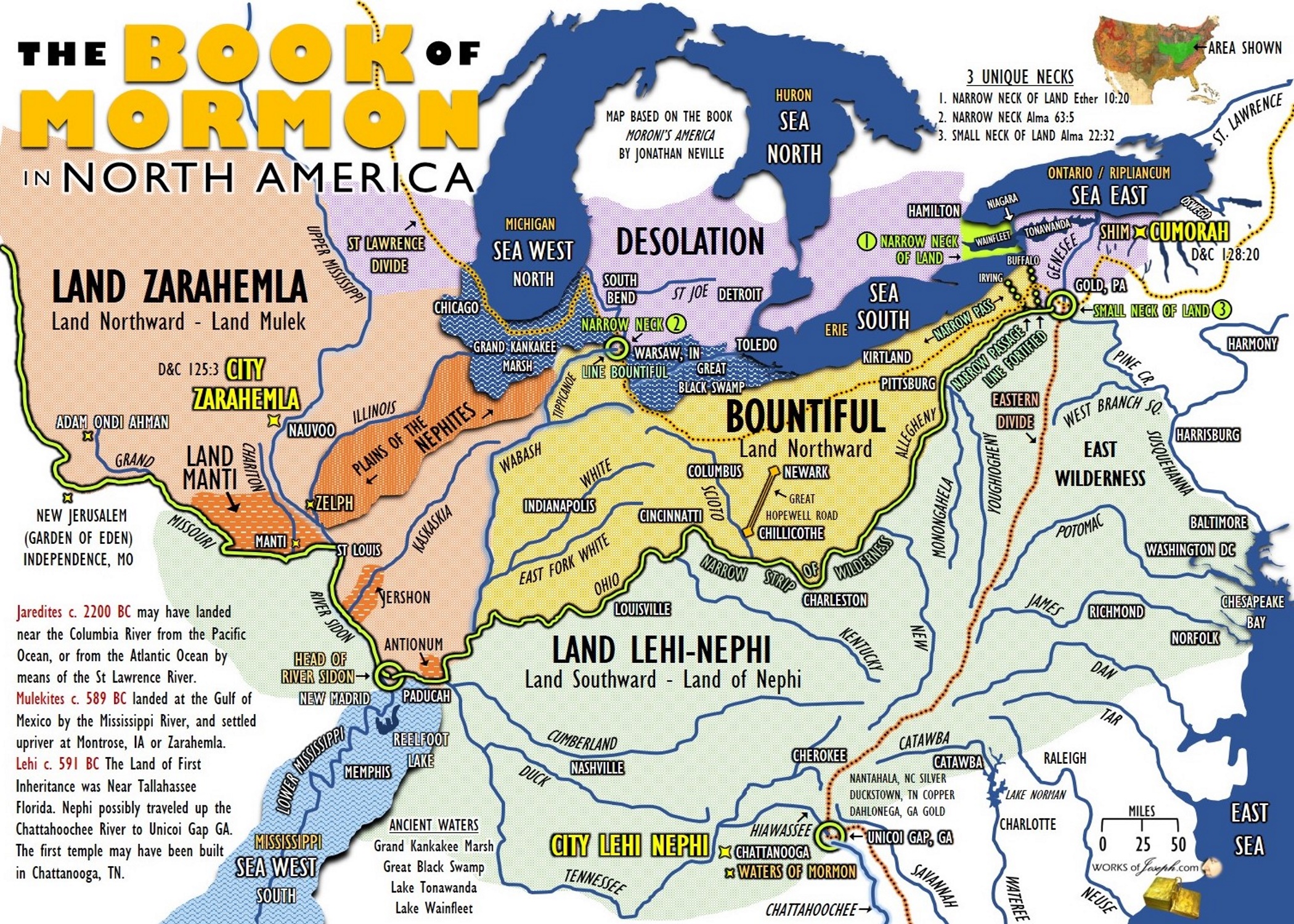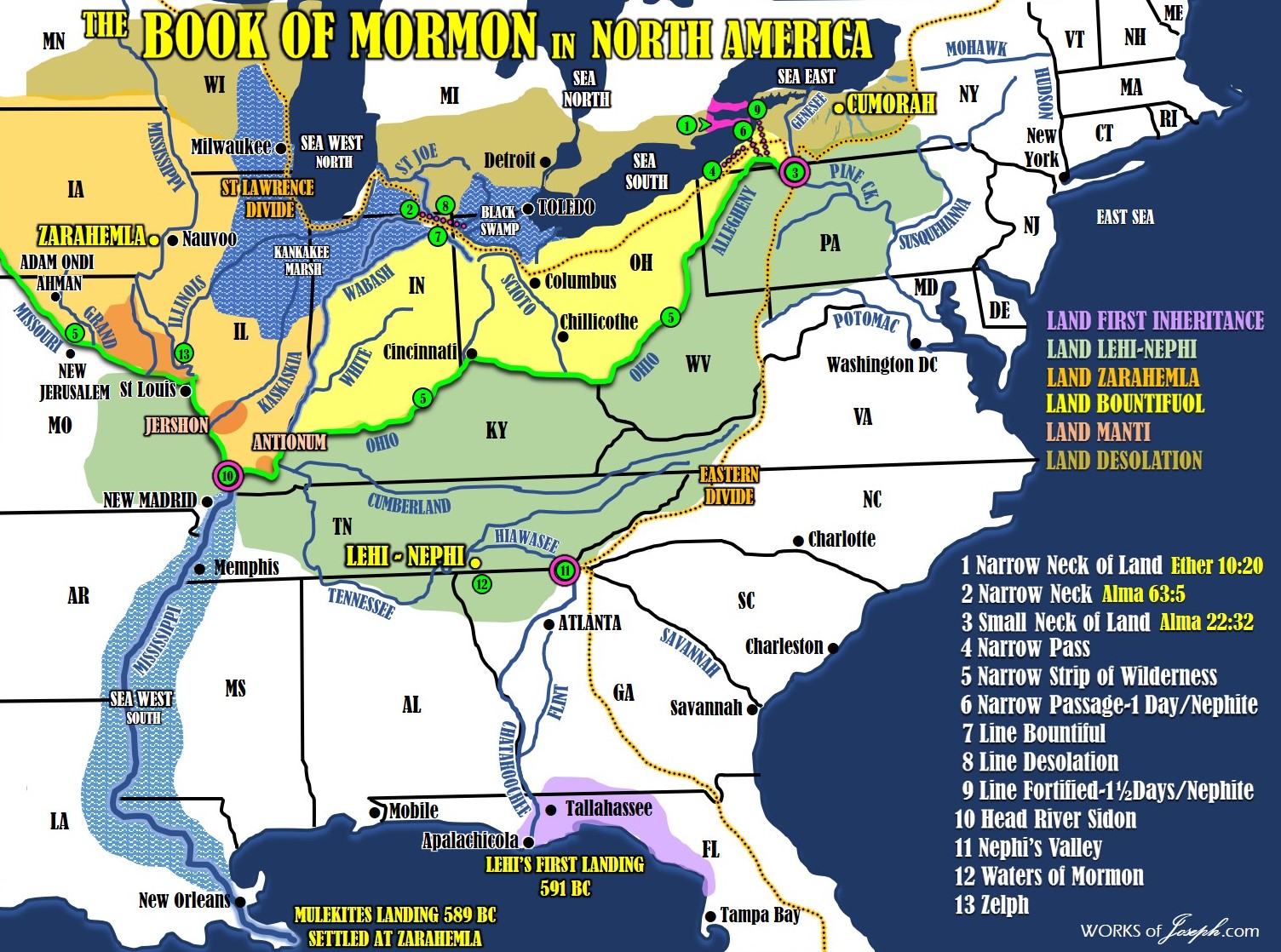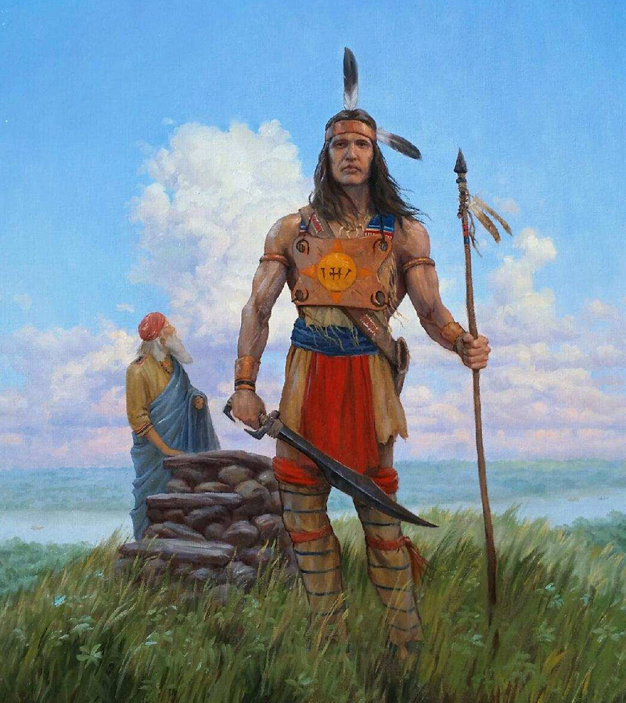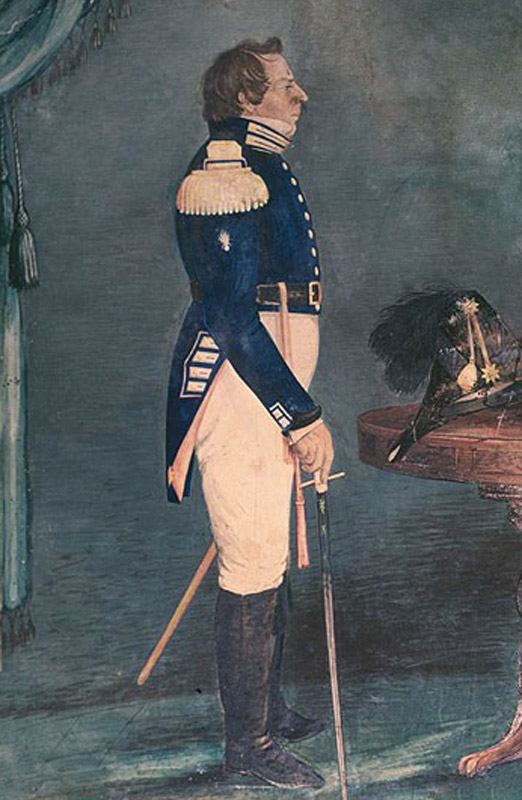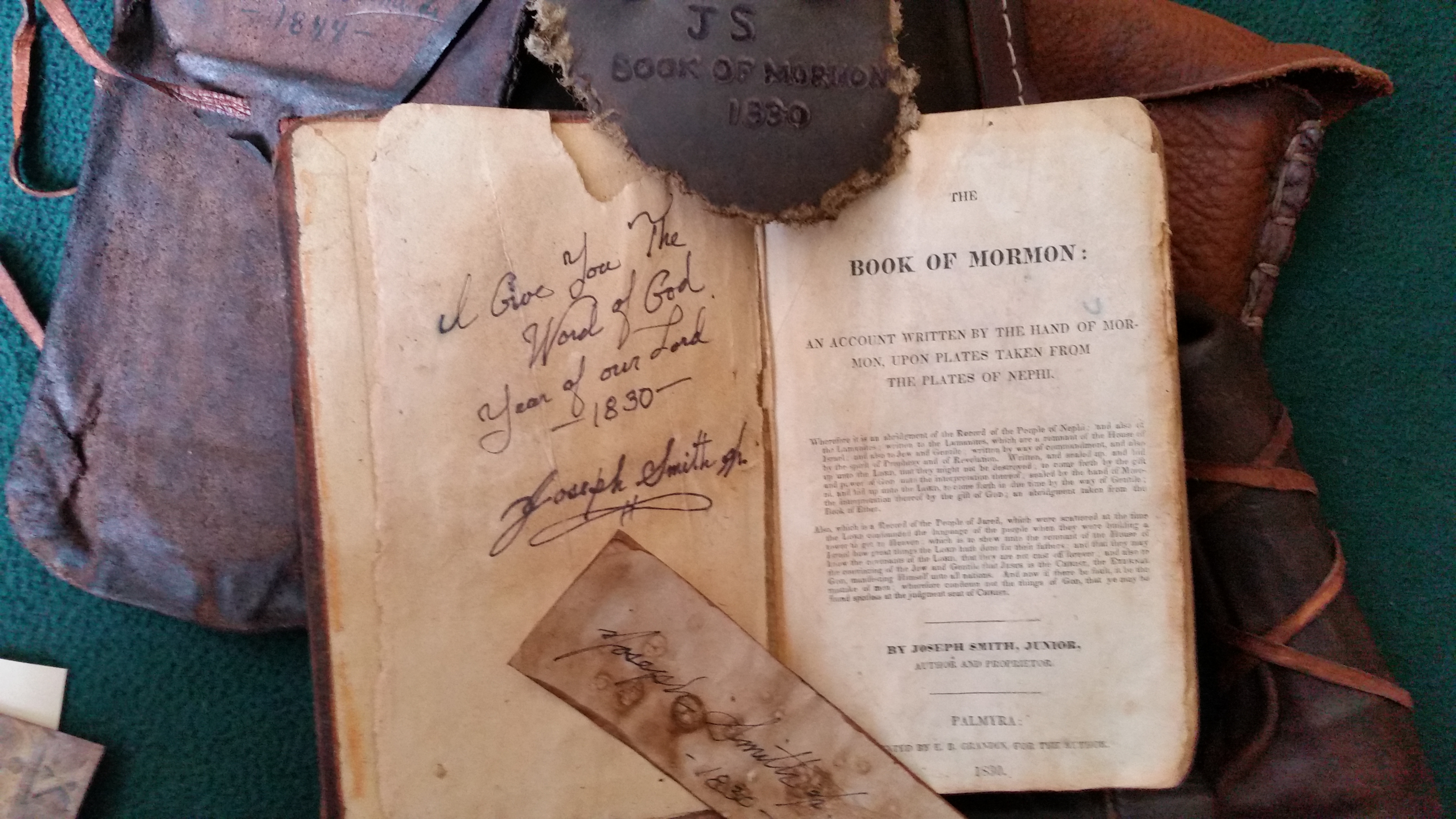The Book of Mormon events took place in Moroni’s America, which is the Heartland of the United States.
THE HEARTLAND OF THE UNITED STATES IS MORONI’S AMERICA
→The Book of Mormon is the Word of God, and a Real History of a Real People
→Hill Cumorah is in Manchester, New York
→The New Jerusalem will be built in Missouri
→Adam-ondi-Ahman is in Daviess County, Missouri
→The “Plains of the Nephites” are in the Midwest (Illinois, Indiana, Ohio)
→Zelph’s mound is near Valley City, Illinois
→Zarahemla is across from Nauvoo at Montrose, Iowa
→Manti is in southeastern Missouri near Huntsville.
THIS IS THE PLACE. There is only “ONE CUMORAH!”
“In the face of this evidence coming from the Prophet Joseph Smith, Oliver Cowdery, and David Whitmer, we cannot say that the Nephites and Lamanites did not possess the territory of the United States and that the Hill Cumorah is in Central America. Neither can we say that the great struggle which resulted in the destruction of the Nephites took place in Central America. (continued below the maps)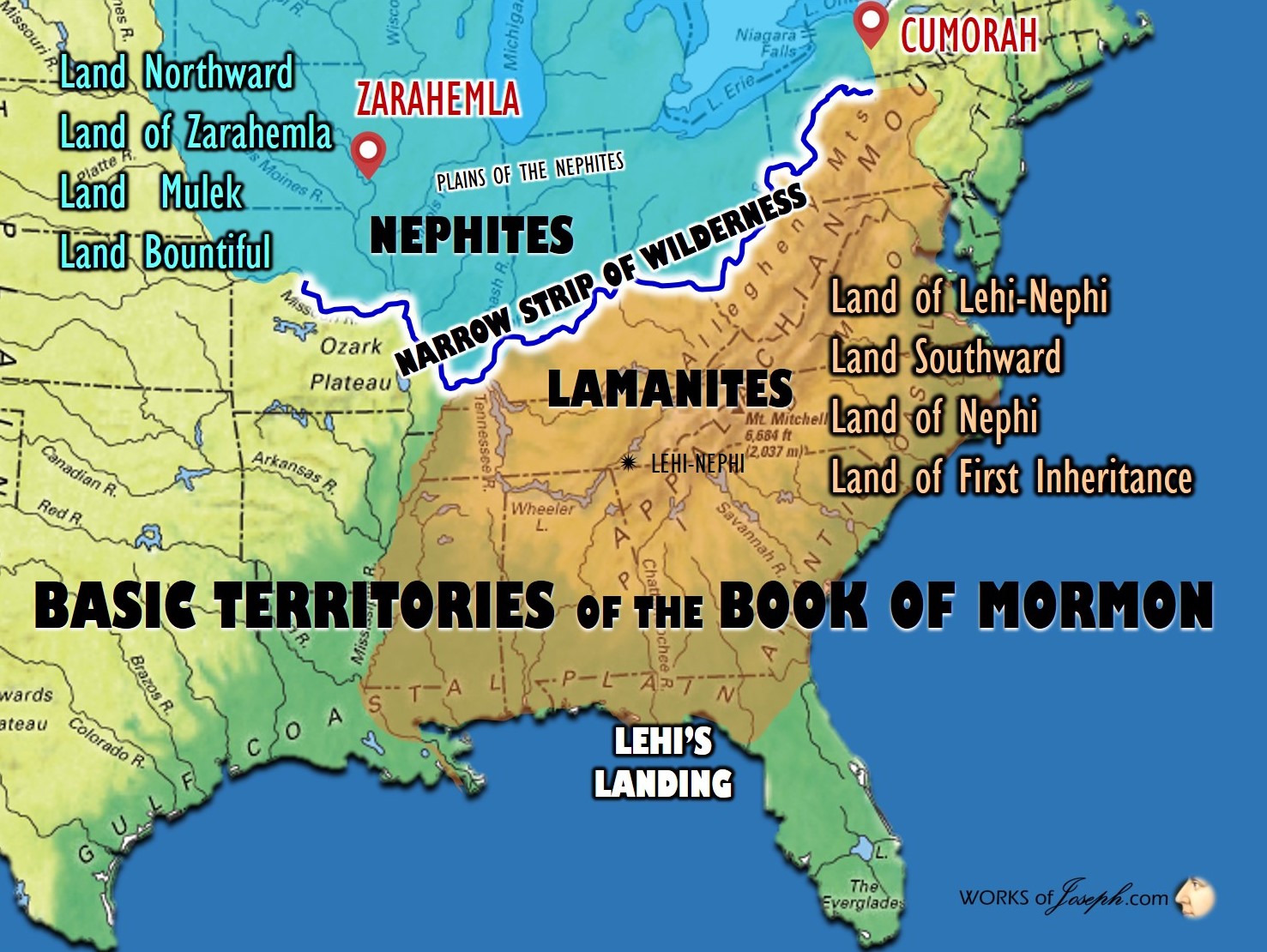
(Continued from above) If Zelph, a righteous man, was fighting under a great prophet-general in the last battles between the Nephites and Lamanites; if that great prophet-general was known from the Rocky Mountains to “the Hill Cumorah or eastern sea,” then some of those battles, and evidently the final battles did take place within the borders of what is now the United States. There were no righteous prophets, save the Three Nephites, after the death of Moroni, and we learn that Zelph was slain during one of these battles during the great last struggle between the Nephites and Lamanites and was buried near the Illinois River. In the Book of Mormon story the Lamanites were constantly crowding the Nephites back towards the north and east. If the battles in which Zelph took part were fought in the country traversed by the Zion’s Camp, then we have every reason to believe from what is written in the Book of Mormon, that the Nephites were forced farther and farther to the north and east until they found themselves in the land of Ripliancum, which both Ether and Mormon declare to us was the land of Ramah or Cumorah, a land of “many waters,” which “by interpretation, is large, or to exceed all.” This being true, what would be more natural then that Moroni, like his father Mormon, would deposit the plates in the land where the battles came to an end and the Nephites were destroyed? This Moroni says he did, and from all the evidence in the Book of Mormon, augmented by the testimony of the Prophet Joseph Smith, these final battles took place in the territory known as the United States and in the neighborhood of the Great Lakes and hills of Western New York. And here Moroni found the resting place for the sacred instruments which had been committed to his care.” Joseph Fielding Smith, Doctrines of Salvation Vol. 3 Ch. 12 (color added)
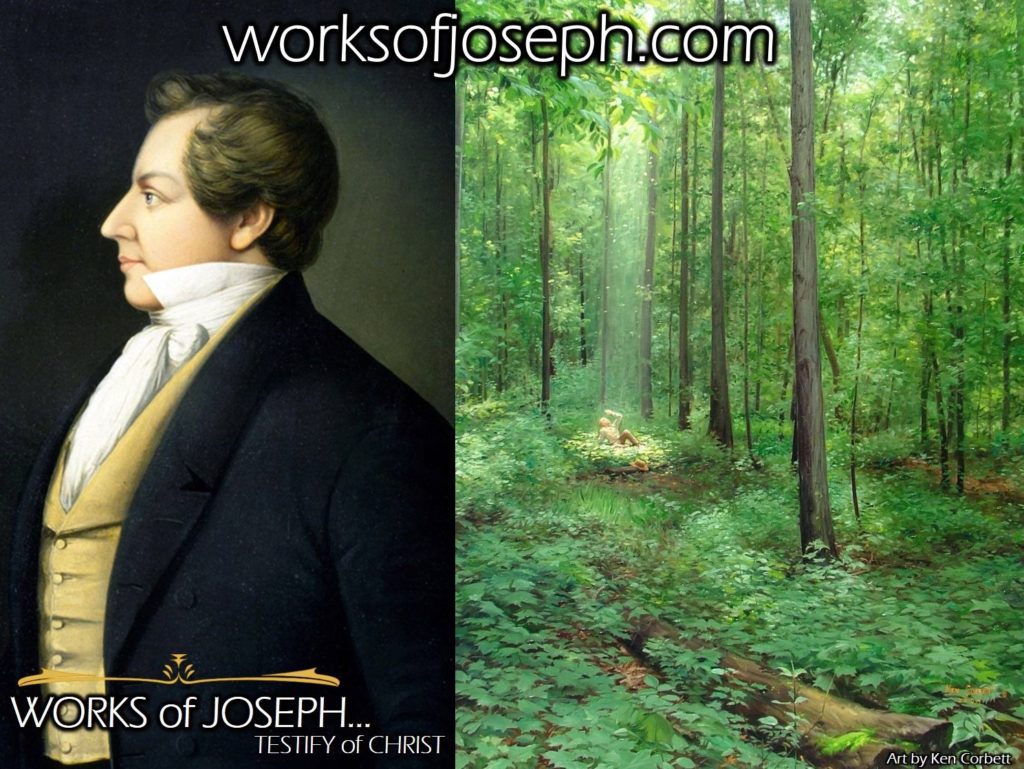 New Discoveries in our Knowledge of the Book of Mormon
New Discoveries in our Knowledge of the Book of Mormon
In 1909, B. H. Roberts wrote: “Let me here say a word in relation to new discoveries in our knowledge of the Book of Mormon, and for matter of that in relation to all subjects connected with the work of the Lord in the earth. We need not follow our researches in any spirit of fear and trembling. We desire only to ascertain the truth; nothing but the truth will endure; and the ascertainment of the truth and the proclamation of the truth in any given case, or upon any subject, will do no harm to the work of the Lord which is itself truth. Nor need we be surprised if now and then we find our predecessors, many of whom bear honored names and deserve our respect and gratitude for what they achieved in making clear the truth, as they conceived it to be–we need not be surprised if we sometimes find them mistaken in their conceptions and deductions; just as the generation who succeed us in unfolding in a larger way some of the yet unlearned truths of the Gospel, will find that we have had some misconceptions and made some wrong deductions in our day and time. . . . All which is submitted, especially to the membership of the Church, that they may be prepared to find and receive new truths both in the Book of Mormon itself and about it.” (B. H. Roberts, New Witnesses for God, Vol. II. (3 Volumes), Deseret News: Salt Lake City, 1909, pp. 503-504)
Editor Opinion
I believe the Prophet Joseph Smith actually knew a great deal about Book of Mormon geography. I believe if you study, read and pray about the Prophet Joseph’s writings, you will find his strong belief in the North American setting for the Book of Mormon. Read Letter VII, Wentworth Letter, Josephs letter to Emma, D&C 28, 30,125, 128 and many other sources that reflect this belief. I believe it is important to know more about where Lehi landed, and Nephi served, and where the final battles of the Nephites happened. It adds to my testimony just as knowing the Lord was born in Bethlehem. Cumorah in New York is the key. This is where the angel appeared to Joseph, where the plates were hidden and the very hill where the Jaredites and Nephites were destroyed.
Below is some great counsel from the LDS Newsroom about our witnesses about Church doctrine. I have felt a deep confirmation for example, that there is only ONE CUMORAH. This knowledge gives me a deeper understanding of the important role that Hill Cumorah played in the coming forth of the Book of Mormon.
“Individual members are encouraged to independently strive to receive their own spiritual confirmation of the truthfulness of Church doctrine. Moreover, the Church exhorts all people to approach the gospel not only intellectually but with the intellect and the spirit, a process in which reason and faith work together.” LDS Newsroom
Joseph Smith Knew the Nephites
 “Such questions have been asked as “How much did the prophet Joseph Smith actually know about Book of Mormon geography?” and “How much of what he knew did he feel at liberty to reveal to his followers?” Joseph Smith was first shown the plates of the Book of Mormon on September 22, 1823, but it was not until the fourth anniversary of that date, i.e., in 1827, that they actually came into his possession. What was he doing during those four years, and why that long wait before he could get on with his important assignment of translating them into English? A recent study documents no fewer than 22 visitations of the angel Moroni to Joseph, as well as appearances of Nephi, Alma, Mormon, and other Book of Mormon notables [Robert J. Woodford, “Book of Mormon Personalities Known by Joseph Smith” The Ensign, Vol. 8, No. 8, August 1978, pp. 12-15; also “The Story of the Doctrine and Covenants,” i.b.i.d., Vol. 14, No. 12, December 1984, pp. 32-39]. Most of these visits were made, no doubt, during this four-year period, and many of them were reported by Lucy Mack Smith, mother of the Prophet, who in her old age dictated a biography of her controversial son. (Smith, 1979) Chapter 18 (pp. 79-85) of Mother Smith’s biography is of particular interest. It starts with the date September 22, 1823, when young Joseph told his father of the visits of Moroni through the previous night. Then, that evening and the next, his whole family gathered about to listen to him.
“Such questions have been asked as “How much did the prophet Joseph Smith actually know about Book of Mormon geography?” and “How much of what he knew did he feel at liberty to reveal to his followers?” Joseph Smith was first shown the plates of the Book of Mormon on September 22, 1823, but it was not until the fourth anniversary of that date, i.e., in 1827, that they actually came into his possession. What was he doing during those four years, and why that long wait before he could get on with his important assignment of translating them into English? A recent study documents no fewer than 22 visitations of the angel Moroni to Joseph, as well as appearances of Nephi, Alma, Mormon, and other Book of Mormon notables [Robert J. Woodford, “Book of Mormon Personalities Known by Joseph Smith” The Ensign, Vol. 8, No. 8, August 1978, pp. 12-15; also “The Story of the Doctrine and Covenants,” i.b.i.d., Vol. 14, No. 12, December 1984, pp. 32-39]. Most of these visits were made, no doubt, during this four-year period, and many of them were reported by Lucy Mack Smith, mother of the Prophet, who in her old age dictated a biography of her controversial son. (Smith, 1979) Chapter 18 (pp. 79-85) of Mother Smith’s biography is of particular interest. It starts with the date September 22, 1823, when young Joseph told his father of the visits of Moroni through the previous night. Then, that evening and the next, his whole family gathered about to listen to him.
From this time forth, Joseph continued to receive instructions from the Lord, and we continued to get the children together every evening for the purpose of listening while he gave us a relation of the same. I presume our family presented an aspect as singular as any that ever lived upon the face of the earth–all seated in a circle, father, mother, sons and daughters, and giving the most profound attention to a boy, eighteen years of age, who had never read the Bible through in his life: he seemed much less inclined to the perusal of books than any of the rest of our children, but far more given to meditation and deep study.
During our evening conversations, Joseph would occasionally give us some of the most amusing recitals that could be imagined. He would describe the ancient inhabitants of this continent, their dress, mode of traveling, and the animals upon which they rode; their cities, their buildings, with every particular; their mode of warfare; and also their religious worship. This he would do with as much ease, seemingly, as if he had spent his whole life among them. (Smith, pp. 82-83) . . . In any case, the Prophet seems to have known a good deal about ancient Nephite civilization. Why, then did he not tell his followers more about such matters as Book of Mormon geography? Because they were not yet ready for it, and because that was not what the Church was to become involved in at that stage of development. It would seem, however, that he at least left a few clues behind, perhaps to stimulate us of the present generation to further inquiry. (Incidentally, I am not one to accept everything Joseph Smith ever said or wrote as automatically binding; he was a human being like the rest of us. But I do believe he had special insights, and whatever he may have had to say–even on a subject like Book of Mormon geography–is worthy of careful consideration.)” Ross T. Christensen at the Thirty-third Annual Symposium on the Archaeology of the Scriptures, held at BYU on September 28 and 29, 1984.
Joseph Smith Among the Prophets by Robert L. Millet
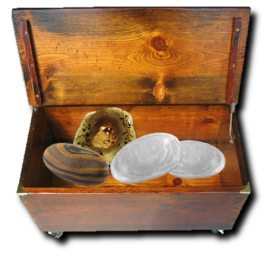 “He is the preeminent witness of Christ in this the final dispensation. Joseph Smith, the Mormon prophet, was little understood by the people of the nineteenth century and may be even more of a puzzle to those who live at the end of the twentieth. “No man knows my history,” he said once. “I cannot tell it: I shall never undertake it. I don’t blame any one for not believing my history. If I had not experienced what I have, I would not have believed it myself” (History of the Church, 6:317). Like his Master, Jesus Christ, Joseph Smith was called upon to endure a certain kind of loneliness in life. This farm boy who grew to become a prophet could bear a personal witness of the divine Redeemer, for, like Jesus, Joseph was also, to some degree at least, a man of sorrows and acquainted with grief (Isa. 53:3). His life was characterized not only by persecution and suspicion, but also by an isolation known only to those who walk in the glorious rays of the noonday sun and yet must minister among others content to walk in the fading light of dusk. “God is my friend,” he wrote to his wife Emma at a difficult time. “In him I shall find comfort. I have given my life into his hands. I am prepared to go at his call. I desire to be with Christ. I count not my life dear to me, only to do his will” (in The Personal Writings of Joseph Smith, compiled by Dean C. Jessee, Salt Lake City: Deseret Book Company, 1984, page 239; punctuation and spelling corrected). Such expressions give us a glimpse of the underlying secret of his humility and success: he knew, and he wanted all others to know, that he walked in the light of the Almighty. He was the covenant spokesman of the Almighty; God knew it, and he knew it.
“He is the preeminent witness of Christ in this the final dispensation. Joseph Smith, the Mormon prophet, was little understood by the people of the nineteenth century and may be even more of a puzzle to those who live at the end of the twentieth. “No man knows my history,” he said once. “I cannot tell it: I shall never undertake it. I don’t blame any one for not believing my history. If I had not experienced what I have, I would not have believed it myself” (History of the Church, 6:317). Like his Master, Jesus Christ, Joseph Smith was called upon to endure a certain kind of loneliness in life. This farm boy who grew to become a prophet could bear a personal witness of the divine Redeemer, for, like Jesus, Joseph was also, to some degree at least, a man of sorrows and acquainted with grief (Isa. 53:3). His life was characterized not only by persecution and suspicion, but also by an isolation known only to those who walk in the glorious rays of the noonday sun and yet must minister among others content to walk in the fading light of dusk. “God is my friend,” he wrote to his wife Emma at a difficult time. “In him I shall find comfort. I have given my life into his hands. I am prepared to go at his call. I desire to be with Christ. I count not my life dear to me, only to do his will” (in The Personal Writings of Joseph Smith, compiled by Dean C. Jessee, Salt Lake City: Deseret Book Company, 1984, page 239; punctuation and spelling corrected). Such expressions give us a glimpse of the underlying secret of his humility and success: he knew, and he wanted all others to know, that he walked in the light of the Almighty. He was the covenant spokesman of the Almighty; God knew it, and he knew it.
Known by the Ancients
The dispensation of the fulness of times was destined to bring to consummation the work of the Lord. Because this era would be a time when God would “gather together … all things in Christ, both which are in heaven, and which are on earth” (Eph. 1:10), it was a day anticipated and longed for by the early Saints. It was known and spoken of by them, as was the man who would lead the final dispensation.
 President Brigham Young thus observed concerning Joseph Smith: “It was decreed in the counsels of eternity, long before the foundations of the earth were laid, that he, Joseph Smith, should be the man, in the last dispensation of this world, to bring forth the word of God to the people, and receive the fulness of the keys and power of the Priesthood of the Son of God.The Lord had his eye upon him, and upon his father, and upon his father’s father, and upon their progenitors clear back to Abraham, and from Abraham to the flood, from the flood to Enoch, and from Enoch to Adam. He has watched that family and that blood as it has circulated from its fountain to the birth of that man. He was foreordained in eternity to preside over this last dispensation” (in Discourses of Brigham Young, selected by John A. Widtsoe, Salt Lake City: Deseret Book Company, 1954, page 108; emphasis added).
President Brigham Young thus observed concerning Joseph Smith: “It was decreed in the counsels of eternity, long before the foundations of the earth were laid, that he, Joseph Smith, should be the man, in the last dispensation of this world, to bring forth the word of God to the people, and receive the fulness of the keys and power of the Priesthood of the Son of God.The Lord had his eye upon him, and upon his father, and upon his father’s father, and upon their progenitors clear back to Abraham, and from Abraham to the flood, from the flood to Enoch, and from Enoch to Adam. He has watched that family and that blood as it has circulated from its fountain to the birth of that man. He was foreordained in eternity to preside over this last dispensation” (in Discourses of Brigham Young, selected by John A. Widtsoe, Salt Lake City: Deseret Book Company, 1954, page 108; emphasis added).
Others knew of the coming of Joseph Smith in the last days and of the vital role he would play in the winding-up scenes. Joseph of old (see 2 Ne. 3:7, 18), the resurrected Savior to the Nephites (see 3 Ne. 21:9–11), Moroni (see Morm. 8:14–16, 23–25), and John the Baptist (see JST, John 1:20–22) all spoke of a great prophet, a great Elias who was to restore all things before the second coming of the Messiah. (SeeTeachings of the Prophet Joseph Smith, page 364.)
There is another sense in which Joseph Smith was known to the ancients: he was schooled and tutored by them during his own mortal ministry. Save Jesus Christ only, the world has never known a more competent scriptural authority than Joseph Smith. It is one thing to read a book of scripture and quite another to be personally instructed by its authors. Who among the world’s scholars and religious leaders can lay claim to having stood face to face with Adam, Enoch, Noah, Moses, Elijah, John the Baptist, Peter, James, and John? Who can speak with authority about life in ancient America because of lessons learned from Nephi, Mormon, Moroni, and other ancient American Hebrews? (See Journal of Discourses, 13:47; 17:374; 21:94, 161–64; 23:362.) Many of Joseph’s heavenly visitors laid their hands on his head and conferred their priesthood keys and authorities. (See D&C 128:20.)
In summarizing these events, President John Taylor said: “Joseph Smith in the first place was set apart by the Almighty according to the counsels of the gods in the eternal worlds, to introduce the principles of life. … The principles which he had, placed him in communication with the Lord, and … with the ancient apostles and prophets; such men, for instance, as Abraham, Isaac, Jacob, Noah, Adam, Seth, Enoch, and Jesus and the Father, and the apostles that lived on this continent as well as those who lived on the Asiatic continent. He seemed to be as familiar with these people as we are with one another. Why? Because he had to introduce a dispensation which was called the dispensation of the fulness of times, and it was known as such by the ancient servants of God” (in Journal of Discourses, 21:94; emphasis added). Joseph Smith knew the scriptures, he knew their precepts, he knew their prophets, and he knew the central character—the Lord Jesus Christ.
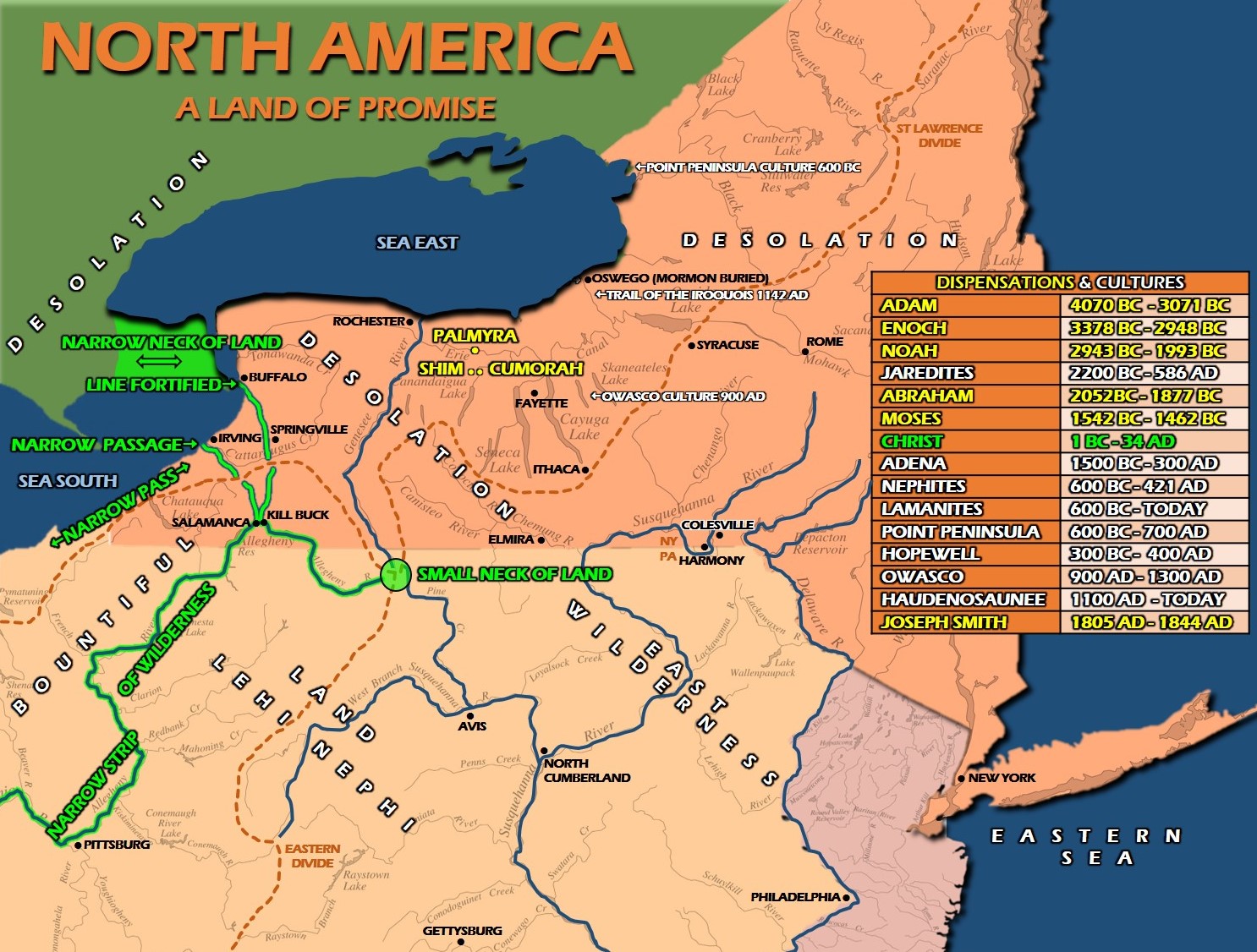 A Dispensation Head
A Dispensation Head
The Apostle Paul explained that “the spirits of the prophets are subject to the prophets” (1 Cor. 14:32). There is an order even among those called as oracles and mouthpieces of the Almighty.
Elder Bruce R. McConkie observed: “You start out with the Lord Jesus, and then you have Adam and Noah. Thereafter come the dispensation heads. Then you step down, appreciably, and come to prophets and apostles, to the elders of Israel, and to wise and good and sagacious men who have the spirit of light and understanding” (“This Generation Shall Have My Word through You,” in Hearken O Ye People: Discourses on the Doctrine and Covenants, Sperry Symposium 1984, Sandy, Utah: Randall Book Company, 1984, page 4).
Joseph Smith, like Adam, Enoch, Noah, Abraham, Moses, and others, stands as a dispensation head. The dispensation head becomes the means by which the knowledge and power of God are channeled to men and women on earth. He becomes the means by which the gospel of Jesus Christ—the plan of salvation and exaltation—is revealed anew, the means by which divine transforming powers, including saving covenants and ordinances, are extended to people during an age of time called a dispensation. The dispensation head stands as the preeminent prophetic witness of Christ; he knows firsthand because of what he has seen and heard and felt and experienced. Because of his central place in the plan, because it is by means of the power of his testimony that men and women come to know the Lord and bask in the light of the Spirit, the calling and position of the dispensation head thus becomes something to which his followers bear witness.
Elder McConkie thus pointed out: “Every prophet is a witness of Christ; every dispensation head is a revealer of Christ for his day; and every other prophet or apostle who comes is a reflection and an echo and an exponent of the dispensation head. All such come to echo to the world and to expound and unfold what God has revealed through the man who was appointed for that era to give his eternal word to the world” (“This Generation Shall Have My Word through You,” pages 4–5).
To be sure, we worship the Father in the name of the Son; Christ our Lord is the way to the Father, and his is the only name under heaven whereby man can be saved. But, as we have seen, the dispensation head is the preeminent prophetic revealer of Christ. Thus, to bear witness of Joseph Smith is to bear witness of Jesus Christ, who sent him, in the same way that a testimony of Christ also implies clearly a testimony of the Eternal Father, who sent Him. On the other hand, to deny Joseph Smith outright—to deny the spiritual impressions which attest to his prophetic assignment—is to deny the Lord, who sent him. Jesus told his disciples that “he that despiseth you despiseth me; and he that despiseth me despiseth him that sent me” (Luke 10:16; compare D&C 1:38; D&C 84:36; D&C 112:20).
There is a supernal power, an unusual spiritual endowment from that Lord we worship, associated with bearing a pure and fervent testimony of Joseph Smithand the Restoration. Such outpourings surely signify heaven’s approbation. President Joseph F. Smith, nephew of the Prophet, declared: “I believe in the divinity of Jesus Christ, because more than ever I come nearer the possession of the actual knowledge that Jesus is the Christ, the son of the living God, through the testimony of Joseph Smith … that he saw Him, that he heard Him, that he received instructions from Him, that he obeyed those instructions” (Gospel Doctrine, Salt Lake City: Deseret Book Company, 1919, page 495; emphasis added).
“… Save Jesus Only”
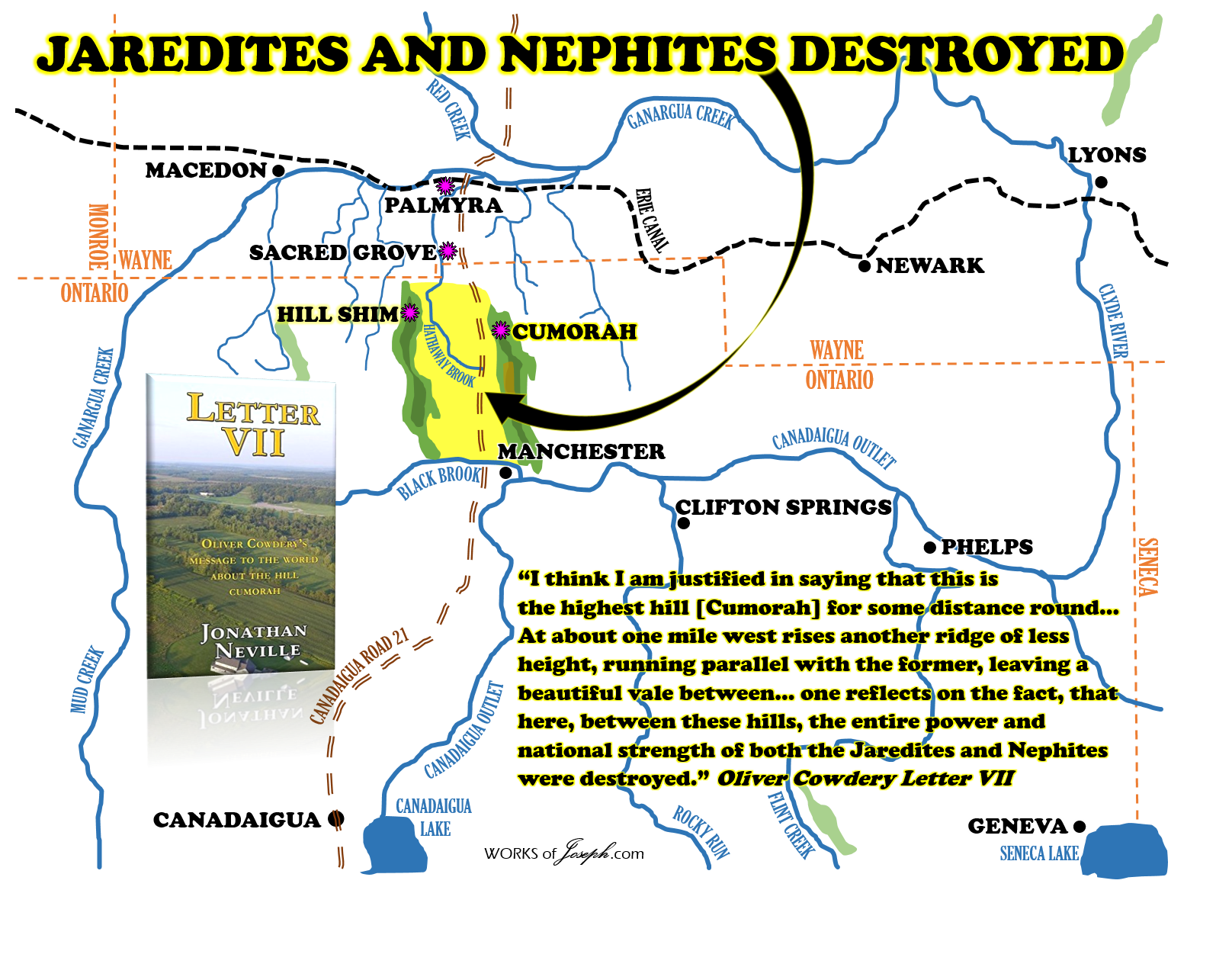 It is not difficult to catch an occasional glimpse of the singular role of Joseph Smith in this final age of the world. In a spirit of gratitude and tribute, Elder John Taylor, a man not prone to hyperbole, wrote: “Joseph Smith, the Prophet and Seer of the Lord, has done more, save Jesus only, for the salvation of men in this world, than any other man that ever lived in it” (D&C 135:3). More than Enoch? More than Abraham? More than Jacob? More than Moses? What did Elder Taylor mean? We might consider the following possibilities:
It is not difficult to catch an occasional glimpse of the singular role of Joseph Smith in this final age of the world. In a spirit of gratitude and tribute, Elder John Taylor, a man not prone to hyperbole, wrote: “Joseph Smith, the Prophet and Seer of the Lord, has done more, save Jesus only, for the salvation of men in this world, than any other man that ever lived in it” (D&C 135:3). More than Enoch? More than Abraham? More than Jacob? More than Moses? What did Elder Taylor mean? We might consider the following possibilities:
1. Joseph Smith serves as the legal administrator associated with that period of time prophesied by Joel when the Lord would pour out his Spirit upon all flesh (see Joel 2:28–29). When Moroni first appeared to Joseph in September 1823, he quoted these verses in Joel and said “that this was not yet fulfilled, but was soon to be” (JS—H 1:41). In the years since Moroni’s visit, many have indeed dreamed dreams and seen visions. Above all else, the Spirit of God has been the driving influence behind the dissemination of eternal truth and the spiritual transformation of those who have submitted to the terms and conditions of the restored gospel of Jesus Christ.
In addition, this Spirit has affected those outside the faith. President Joseph Fielding Smith, after quoting the prophecy of Joel, provided the following insight: “There have been a great many discoveries. In fact, since the establishment of the gospel, these discoveries and inventions have been increasing more rapidly and we have seen more, perhaps, … than was seen during all the years from the days of the revival of learning and the reformation down to the visitation of Moroni to the Prophet Joseph Smith” (Doctrines of Salvation, 3 volumes, Salt Lake City: Bookcraft, 1954–56, 1:179). In short, the Spirit of God—meaning the Light of Christ—has been behind the rapid intellectual, scientific, and technological developments from the time of the Industrial Revolution to our own Information Age. Joseph Smith presides over our age of enlightenment and expansion.
2. Though we thrill in the knowledge that God continues to guide his church and kingdom, most of what we know today in the form of doctrine has come to us through Joseph Smith. His call initiated the “times of restitution of all things, which God hath spoken by the mouth of all his holy prophets since the world began” (Acts 3:21), a day of restoration that will continue throughout the Millennium. It is called the dispensation of the fulness of times. Joseph Smith was raised up to make known “those things which never have been revealed from the foundation of the world, but have been kept hid from the wise and prudent, [things that] shall be revealed unto babes and sucklings in this, the dispensation of the fulness of times” (D&C 128:18; see also D&C 124:41).
3. With the visit of the Savior to the postmortal spirit world, the work of the redemption of the dead began. But after the period of the Great Apostasy, this responsibility came to rest with the final dispensation. Think on it! Joseph Smith and his successors bear a major responsibility for the teaching of the gospel in the world of spirits and the performance of saving ordinances for literally billions of our Father’s children.
President Brigham Young uttered this bold statement: “Joseph Smith holds the keys of this last dispensation, and is now engaged behind the vail in the great work of the last days. … No man or woman in this dispensation will ever enter into the celestial kingdom of God without the consent of Joseph Smith. From the day that the Priesthood was taken from the earth to the winding-up scene of all things, every man and woman must have the certificate of Joseph Smith, junior, as a passport to their entrance into the mansion where God and Christ are. … He holds the keys of that kingdom for the last dispensation—the keys to rule in the spirit world. …
“Should not this thought comfort all people? They will, by-and-by, be … thankful for such a man as Joseph Smith, junior. … It is his mission to see that all the children of men in this last dispensation are saved, that can be, through the redemption” (in Journal of Discourses,7:289; emphasis added).
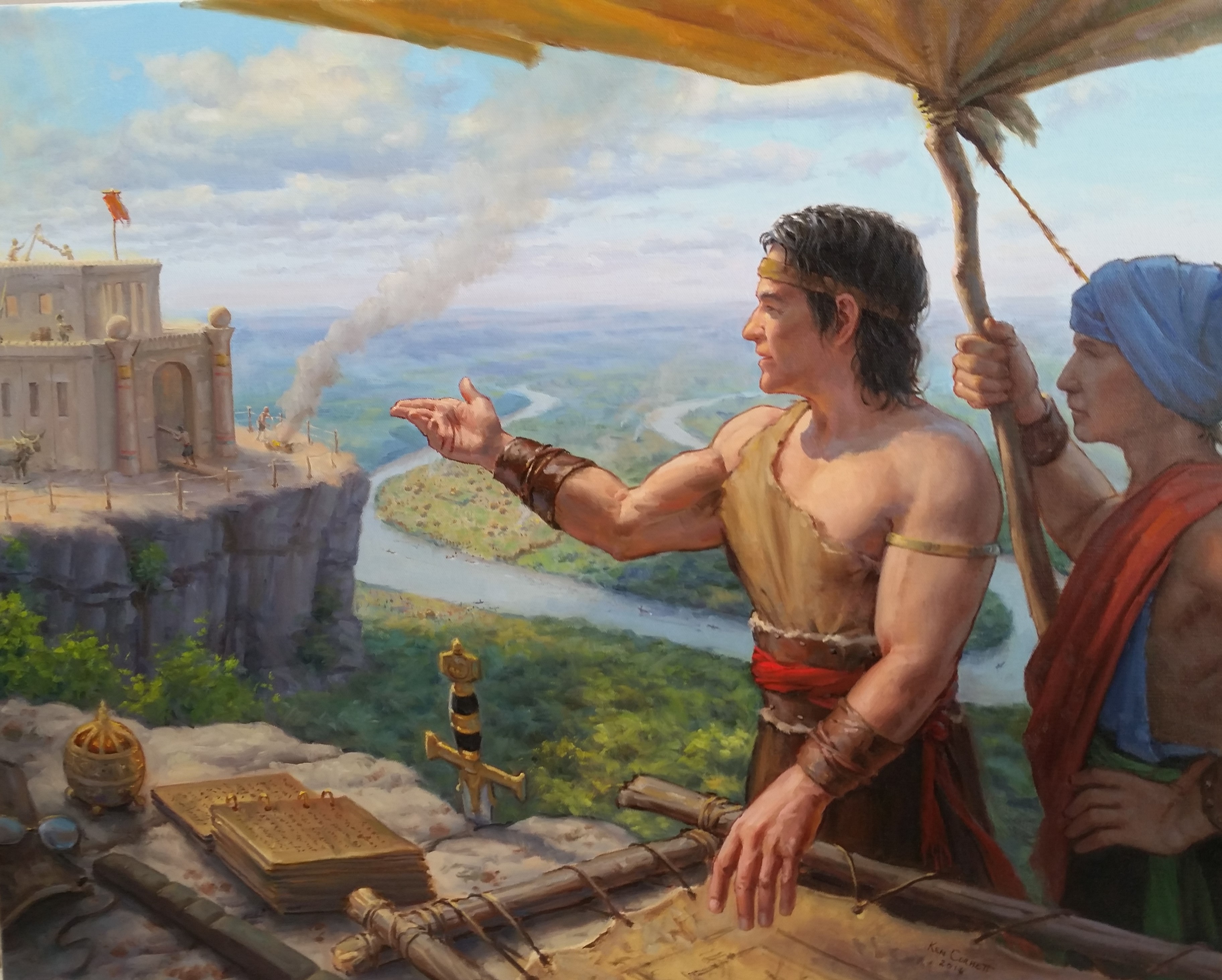 A Tribute
A Tribute
As suggested earlier, the life of Joseph Smith in some degree followed the pattern set by his Master, Jesus Christ. That pattern holds true even when extended to its tragic conclusion. Like his Master, Joseph Smith also shed his blood in order that the final testament, the reestablishment of the new covenant, might be in full effect. (See Heb. 9:16.) Just prior to his death, the Prophet Joseph was reported to have remarked:
“I am tired, I have been mobbed, I have suffered so much. Some of the brethren think they can carry this work out better than I can, far better. I have asked the Lord to take me out of this world. I have stood all I can. I have to seal my testimony to this generation with my blood. I have to do it, for this work will never progress until I am gone, for the testimony is of no force until the testator is dead. People little know who I am when they talk about me, and they never will know until they see me weighed in the balance in the kingdom of God. Then they will know who I am, see me as I am” (Mary Elizabeth Rollins Lightner, in They Knew the Prophet,compiled by Hyrum and Helen Mae Andrus, Salt Lake City: Bookcraft, 1974, pages 26–27).
President Brigham Young offered this testimonial: “Who can justly say aught against Joseph Smith? … I am bold to say that, Jesus Christ excepted, no better man ever lived or does live upon this earth” (Discourses of Brigham Young, page 459). Elder Wilford Woodruff observed: “There is not so great a man as Joseph standing in this generation. … His mind, like Enoch’s, expands as eternity, and only God can comprehend his soul” (In Journal History, 9 April 1837).
One of the significant challenges we face as Latter-day Saints at the close of the twentieth century is to be true and faithful to the legacy Joseph Smith left us. The Psalmist declared that in the last days the wicked would strike at the foundations of the faith of believers (see JST, Ps. 11:1–3) and would seek to undermine those fundamental verities which underlie our commitment to the church and kingdom of God. This has entailed and will yet entail attempts—both vicious and subtle—to malign the name and labors of Joseph Smith, the founding prophet of this dispensation. But be it remembered that the God of heaven has called and approved Joseph Smith; those who attempt to mar the name and image of the Prophet of the Restoration will eventually answer to God for their actions.
President George Albert Smith observed: “Many have belittled Joseph Smith, but those who have will be forgotten in the remains of mother earth, and the odor of their infamy will ever be with them, but honor, majesty, and fidelity to God, exemplified by Joseph Smith and attached to his name, will never die” (cited by Harold B. Lee in Conference Report, October 1973, page 166).
Joseph Smith was and is a prophet of the living God. I know that the Lord appeared to him, called him, and empowered him to reveal the Father and Son and the doctrines of salvation to a world that had been wandering for centuries in darkness. May the Lord endow each of us with the commitment and spiritual strength to live as we believe, in order that we can evidence our appreciation for God our Father, for Jesus Christ his Son, d for their preeminent prophetic witness in these last days, Joseph Smith the Prophet.
Gospel Dispensations (dates are approximate)
A gospel dispensation is “a period of time in which the Lord has at least one authorized servant on the earth who bears the holy priesthood and the keys, and who has a divine commission to dispense the gospel to the inhabitants of the earth. When this occurs, the gospel is revealed anew.” There have been many gospel dispensations since Adam. Among these were the dispensations led by Enoch, Noah, Abraham, Moses, and the Lord himself. Other gospel dispensations existed as well, such as those among the Nephites, the Jaredites, and the Lost Tribes of Israel. Although the plan of salvation taught in each age of the world is the same, each dispensation makes a unique contribution. In the dispensation led by Jesus, for example, the Lord fulfilled the earthly requirements of the Atonement. The dispensation led by the Prophet Joseph Smith is “the dispensation of the fulness of times” in which the Lord will bring to culmination all the plans he has set in motion in all ages of the world.” (See Bible Dictionary, “Dispensations.”) Robert L. Millet is dean of Religious Education and professor of ancient scripture at Brigham Young University. (Colored headings added)
Brigham Young about Joseph Smith
“Who can say aught against Joseph Smith? I do not think that a man lives on the earth that knew him any better than I did, and I am bold to say that, Jesus Christ excepted, no better man ever lived or does live upon this earth. I feel like shouting Hallelujah all the time, when I think that I ever knew Joseph Smith, the Prophet.” Millennial Star, XXI (July 11, 1863)
Wilford Woodruff about Joseph Smith
“The Prophet called the Quorum of the Twelve together several months before his death, and informed them that the Lord had commanded him to hasten their endowments; that he did not expect to remain himself to see the Temple completed; that he wished to confer the keys of the Kingdom of God upon other men, that they might build up the Church and Kingdom according to the pattern given. The Prophet stood before the Twelve from day to day, clothed with the spirit and power of God, and instructed them in the oracles of God, in the pattern of heavenly things, in the keys of the Kingdom, in the power of the priesthood, and in the knowledge of the last dispensation of the fulness of times.
In his last charge to the Quorum of the Twelve, he rose up in all the majesty, strength, and dignity of his calling, as a prophet, seer, and revelator, out of the loins of ancient Joseph, and exhorted and commanded the brethren of the Twelve to rise up, and go forth in the name of Israel’s God, and bear off the keys of the Kingdom of God in righteousness and in honor in all the world. They were instructed to walk in all holiness, godliness, faith, virtue, temperance, patience, and charity; to do honor to the cause of God in this last dispensation and fulness of times; and when their work was finished, to follow his example by boldly sealing their testimony with their blood, for the word of God, and the testimony of Jesus Christ, if necessity required it, that they might be prepared for the reward, which is beyond the veil.
Those who were present on those occasions cannot forget the teachings that fell from the lips of that noble, but now martyred Prophet of God. Though his body sleeps in the tomb, his testimony lives, not only in the hearts of men, but is on record and will remain in force, while his persecutors will reap a just reward for all their works. And I hereby bear my testimony unto all men into whose hands these lines may fall, that I have been acquainted with Joseph, and Hyrum Smith, the Prophet and the Patriarch of the Church of Jesus Christ of Latter-day Saints; have attended their private and public counsels from time to time, during the last ten years of my life; and notwithstanding their enemies have caused the earth to be deluged, as it were, with lies, slanders, and fabrications, with the intent to injure their character and destroy their influence among men; that I have never heard either of those men teach, counsel, or advocate, or practice any principle that was contrary to the word of God, virtue, or temperance, or unbecoming men standing in their high and holy calling. On the contrary, I have been astonished at the patience, forbearance, long-suffering, philanthropy, and charity manifested in the lives of those men. I have been filled with joy by the beauty, order, knowledge, principles, intelligence, and glory manifest in the teachings, counsels, and revelations of Jesus Christ given through those servants of God, for the benefit of the children of men in this last dispensation.” WILFORD WOODRUFF FOURTH PRESIDENT OF THE CHURCH OF JESUS CHRIST OF LATTER-DAY SAINTS History of His Life and Labors AS RECORDED IN HIS DAILY JOURNALS “To him that overcometh will I grant to sit with me in my throne, even as I also overcame, and am set down with my Father in his throne.”—Rev. 3:21. PREPARED FOR PUBLICATION BY MATTHIAS F. COWLEY Salt Lake City, Utah 1909
